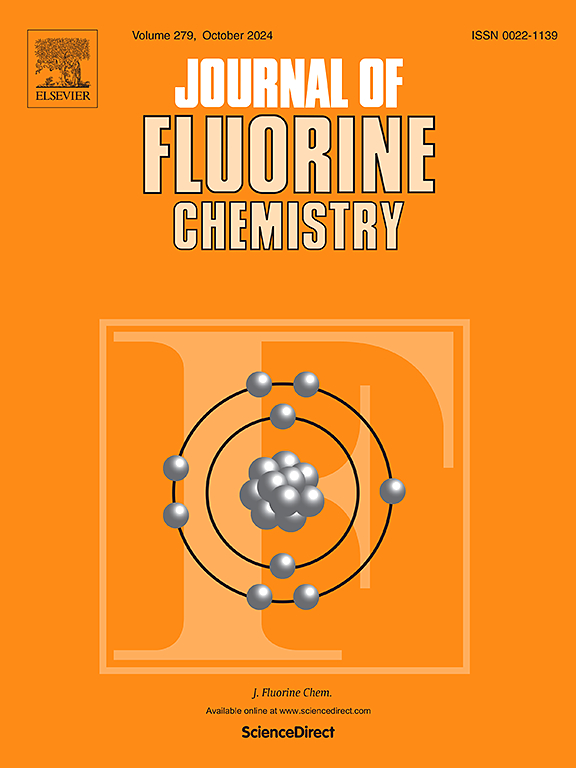Synthesis of poly [2,3,5,6-tetrafluoro-4-(trifluoromethyl) phenylaminophosphazene]/LiNbO3 nanocomposites and characterization of their morphological, mechanical, and piezoelectric behavior for energy harvesting applications
IF 1.9
4区 化学
Q3 CHEMISTRY, INORGANIC & NUCLEAR
引用次数: 0
Abstract
The use of polymer nanocomposites for piezoelectric energy harvesting applications has created exciting opportunities in flexible electronics. In this research, we synthesized poly [2,3,5,6-tetrafluoro-4-(trifluoromethyl)phenylaminophosphazene (PTPP)]/LiNbO₃ nanocomposites by incorporating trigonal crystalline lithium niobate nanoparticles (average particle size ∼ 45 nm) into PTPP via solution casting method. Further, we investigated the effects of different concentrations of lithium niobate (LiNbO₃) nanoparticles on the thermal, mechanical, and piezoelectric performance of the PTPP nanocomposites. The synthesized nanocomposites exhibited strong interfacial interactions between the organic and inorganic phases, resulting in a uniform morphology across all compositions, except for the 8 % loading, which showed some agglomeration. Additionally, both PTPP and its nanocomposites demonstrated high thermal stability, with the highest char yield of 64.1 % observed at 8 % LiNbO₃ loading. Mechanical testing revealed a significant improvement in tensile strength (224 %) and a reduction in elongation at break (34.4 %) with 8 % LiNbO₃ loading. These enhancements in thermal and mechanical properties were attributed to the presence of strong C-F bonds and LiNbO₃ content in the nanocomposites. Besides this, dynamic mechanical analysis indicated that 8 % LiNbO₃-loaded PTPP nanocomposite also exhibited the lowest tan δ value of 0.68 and the highest energy storage capacity with minimal loss over a high-temperature range due to the restricted mobility of polymer chain with the addition of nanoparticles. PTPP also exhibited a piezoelectric effect with a coefficient of 26.4 pC/N, which was further enhanced by the incorporation of LiNbO₃, reaching a maximum increase of 6.4 %. These novel nanocomposites show great potential for energy-harvesting applications in electronic devices.

聚[2,3,5,6-四氟-4-(三氟甲基)苯基氨基磷腈]/LiNbO3纳米复合材料的合成及其形态、力学和压电性能表征
聚合物纳米复合材料用于压电能量收集应用,为柔性电子领域创造了令人兴奋的机会。在本研究中,我们通过溶液铸造法将三角晶体铌酸锂纳米颗粒(平均粒径~ 45 nm)加入到PTPP中,合成了聚[2,3,5,6-四氟-4-(三氟甲基)苯基氨基磷腈(PTPP)]/LiNbO₃纳米复合材料。此外,我们研究了不同浓度的铌酸锂(LiNbO₃)纳米颗粒对PTPP纳米复合材料的热、力学和压电性能的影响。所合成的纳米复合材料在有机相和无机相之间表现出强烈的界面相互作用,除了8%的负载表现出一定的团聚外,所有成分的形貌都是均匀的。此外,PTPP和它的纳米复合材料都表现出很高的热稳定性,在8%的LiNbO₃负载下,观察到最高的炭产率为64.1%。机械测试显示,在8%的LiNbO₃载荷下,拉伸强度(224%)有显著提高,断裂伸长率(34.4%)降低。这些热性能和机械性能的增强是由于纳米复合材料中存在强C-F键和LiNbO₃含量。此外,动态力学分析表明,负载8% LiNbO₃的PTPP纳米复合材料也表现出最低的tan δ值0.68,由于纳米颗粒的加入限制了聚合物链的迁移性,在高温范围内具有最小的损失和最高的储能容量。PTPP还表现出26.4 pC/N的压电效应,LiNbO₃的加入进一步增强了PTPP的压电效应,最大增幅为6.4%。这些新型纳米复合材料在电子器件的能量收集应用方面显示出巨大的潜力。
本文章由计算机程序翻译,如有差异,请以英文原文为准。
求助全文
约1分钟内获得全文
求助全文
来源期刊

Journal of Fluorine Chemistry
化学-无机化学与核化学
CiteScore
3.80
自引率
10.50%
发文量
99
审稿时长
33 days
期刊介绍:
The Journal of Fluorine Chemistry contains reviews, original papers and short communications. The journal covers all aspects of pure and applied research on the chemistry as well as on the applications of fluorine, and of compounds or materials where fluorine exercises significant effects. This can include all chemistry research areas (inorganic, organic, organometallic, macromolecular and physical chemistry) but also includes papers on biological/biochemical related aspects of Fluorine chemistry as well as medicinal, agrochemical and pharmacological research. The Journal of Fluorine Chemistry also publishes environmental and industrial papers dealing with aspects of Fluorine chemistry on energy and material sciences. Preparative and physico-chemical investigations as well as theoretical, structural and mechanistic aspects are covered. The Journal, however, does not accept work of purely routine nature.
For reviews and special issues on particular topics of fluorine chemistry or from selected symposia, please contact the Regional Editors for further details.
 求助内容:
求助内容: 应助结果提醒方式:
应助结果提醒方式:


